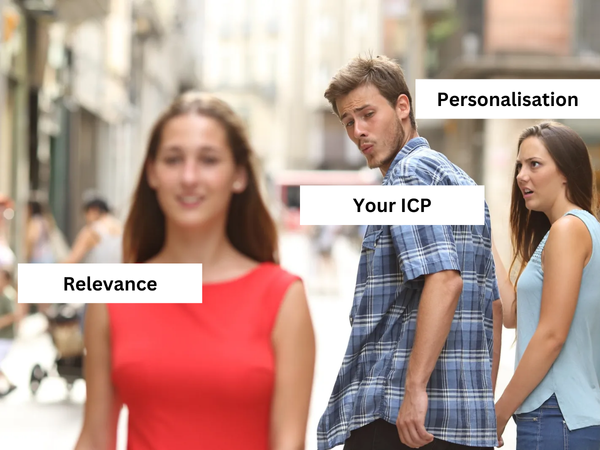The Relevance Rule

Personalisation can grab attention, but relevance is what really makes people care. This is what we call the "Relevance Rule."
When it comes to standing out in a crowded market, building trust and credibility with prospects, adding value is essential.
This is why we advocate for a shift from prospecting to cultivating, with the use of resonant content.
One of the 5 foundations of resonant content is relevance, and in this post we’re going to deep-dive into what this really means, why it differs from personalisation and how to achieve it through targeted research and better writing.
Why Relevance Is So Important
Relevance is everything because it shows that you understand what the other person cares about.
With so many messages flying around every day, you’ve got to make sure yours isn’t just another one to ignore.
As The Ruevy Project puts it, “Relevance in cold emails is about delivering valuable content that addresses the pain points and interests of your target audience”
Personalisation can grab attention, but relevance is what really makes people care.
This is what we call the "Relevance Rule."
Personalisation vs. Relevance: Definitions
Personalisation is when you customise a message by adding specific details about the person, like their name or job title. It’s about making it feel a bit more personal.
Relevance is about making sure your message is important to the person. It’s about answering the question, “Why should they care?”
As Bizible says “The key point is that a message can be highly relevant without being personalised”
An Analogy
Imagine someone’s partner is about to have a big birthday, so they want to get them something special.
They decide to get something really personalised, and opt of a set chefs knives with their partner's name engraved on each handle.
Unfortunately, their partner hates cooking - they’re big into running.
Imagine how they’ll feel when they open this present.
It’s expensive, beautifully packaged and highly personalised - but they’ll hate it anyway, because it shows the sender just doesn’t know them!
If they’d instead bought the latest and greatest running trainers, perhaps they wouldn’t have had their name on it, but the gift would have been highly relevant to them and they’d have loved it.
This is what relevance is to personalisation.
Pros & Cons of Personalisation (without Relevance)
Pros:
- Grabs attention by using personal details.
- Can create a quick connection.
Cons:
- Can feel fake and inauthentic if it’s not relevant.
- People might tune out if it’s just about their name and not their needs. As Detective says, “Personalisation without relevance can come off as lazy or inauthentic”
Pros & Cons of Relevance (without Personalisation)
Pros:
- Directly speaks to the person’s needs and problems.
- More likely to get a positive response.
Cons:
- Might seem too generic if it doesn’t include personal details.
- Needs good data to work well. According to Armadillo CRM, “Relevance should be the primary focus of zero and first party data marketing”
Examples of Good Personalisation
- Congratulating someone on a promotion and offering something that helps with their new role.
- Referring to a specific project they’re working on.
Examples of Bad Personalisation
- Using their name but talking about something that doesn’t matter to them.
- Saying “Congrats on the new job” but then pitching something totally unrelated.
- Using ‘personalisation tags’ and not setting them up correctly so they see ‘Hi <first-name>’ 🙈 (It still happens!)
Examples of Good Relevance
- Sending a message about a problem their company is facing and offering a solution.
- Sharing insights that are directly related to their industry or job role.
Examples of Bad Relevance (Too Generic)
- Trying to create a personal connection based on a relevant ‘fact’ that would be true of almost anyone (a bit like horoscopes)
Here’s one example I got the other day:
- Talking about industry trends without linking it to their specific situation or providing further context on how they might utilise those insights. Don’t make them do the work!
Different Types of Relevance
Relevant to the Prospect Outside of Work:
Mentioning a shared interest, like the sports team they support or a hobby they do, to build a personal connection.
This is not the recommended approach as it requires a deft touch for it not to come across as either creepy or inauthentic.
However in some circumstances it can create a real human connection where it’s very authentic e.g. ‘Hey, I saw you ran the London Marathon last week - so did I…how hard were those final 3 miles?!’
Relevant to the Prospect Inside of Work:
For example, noticing they’ve changed jobs and offering resources to help them in their new position, like a 90 day roadmap or checklist.
Perhaps they’ve won an industry award, just made a hire or put out an open position.
Whatever it is, share some related value that also ties to the broader value proposition you offer (without it turning into a sales pitch).
Relevant to the Specific Role of the Prospect:
For example, addressing challenges specific to their role, like improving marketing ROI or attribution for a CMO.
The key here is to show you actually know your stuff. If its too high level or generic, this won’t feel relevant at all, but if it ties back into their role within the context of their company, industry, tenure, team size etc. then you can quickly make the specificity feel tailored like a glove.
Relevant to the Company of the Prospect:
Discussing how your product can help the company achieve its goals, like expanding into new markets or cutting costs.
You are selling to individuals, but for any reasonably sized deal, they’re going to have to involve multiple stakeholders.
And the thing that binds them together is the context of the company they work for, and it’s stated goals and objectives.
This is therefore one of the most powerful types of relevance you can use.
Relevant to the Industry of the Prospect:
For example, providing industry-specific tips that align with their current challenges.
Again, for it to be seen as usefully relevant here, you need to do more than just state what is likely obvious to them already about big trends.
You need to show how they might impact their particular company and role, and share a point of view.
Points of view are really powerful, as they position you as an authority which is a brilliant combination alongside relevance.
How to Research What Would Be Relevant to the Prospect
In an ideal world, before reaching out to prospects, you’d want to have a view on the following:
- Competitors
- Events & Hooks
- Metrics
- Industry Insights
- SWOT
- Day in the life / role analysis
- DISC Profile
- Challenges & root causes
- Solution & benefits match
These tools and resources are all great to add to your research arsenal:
- Their Site
- Industry Publications
- Social Media
- Review Sites
- Crunchbase
- Glassdoor
- Sales enablement materials & case studies
- ChatGPT
- Clay
- RevvedUp.ai
How to Connect the Relevance to Your Company
One of the hardest parts of the whole relevance game is being able to relate the insight you’re sharing back to your company in a way that feels…relevant! (Too meta?)
The best framework I have to making that switch is to consider the ‘3 Whys’.
Typically our initial insights and outreach, particularly to cold prospects, will focus more at the top of funnel where they’re ‘problem unaware’.
This means you’re trying to get them to grasp ‘why change’ by explaining the challenges or problems they’re likely to have…particularly with shifts in their context.
You can then take them down the path by explaining the ‘so what’ behind this, which is all around what the implications are of not addressing the issue at hand. It helps them to answer ‘why change now’.
And then you can move into the ‘why you’ (the key segue) by explaining how you’re uniquely positioned to help them solve these important and urgent issues.
This sounds like a lot, but it can actually be achieved in just a few lines with great copywriting (or brilliant AI support…hint hint, this is where RevvedUp AI really excels).
Tips, Tricks, and Tactics for Increasing Conversion Rates Through Relevance
Segment Your Audience: Break your audience into smaller groups to make sure your message is relevant to each one. AI can handle a lot of the matching between different types of buyers, but if you have fundamentally different value propositions to different ICPs/personas/market segments, it never hurts to make that clear from the outset.
Test and Optimise: Keep trying different approaches to see what works best. Building engagement with your market is never a ‘once and done’ approach. You need to constantly refine and iterate your approach, using data and analytics to inform future campaigns.
Consistency Helps: If you’re sharing relevant content via social or email; but then sending them to a completely generic landing page or website, it can kill that ‘high touch’ feeling you’ve worked so hard to create further up the funnel - snatching defeat from the jaws of victory.
Use the right Tooling: All of this work to generate consistent, valuable relevance across your communications is super hard work. Or at least it was, when it relied on manual research, a ton of brain processing power, copywriting skills and often a load of brainstorming too.
Now with AI tools like RevvedUp, we can cut out a lot of that cognitive load and repetitive manual work for you, providing more time for you to find new and creative ways to engage prospects and add value.
Learn how to apply the Relevance Rule to all of your outbound content by booking in some time to speak with us.




